II.
THE MEDIEVAL WEAPONS
2 - The Edged-Arms
THE SABRE
(ĐAO - 刀)
The Single Sabre
« Đơn-Đao »
單刀
The Sabre « Đao » ( 刀 ) belongs to the category of Edged Arms, holding a large blade lightly curved and comprrises : « SIngle Sabre - Đơn-Đao » (單 刀) and « Two Matched Sabres - Song Ðao » (双 刀).
The « Single Sabre » is divided into many kinds : « Long Sabre - Trường-Đao » (長 刀), « Short Sabre - Ðoản-Ðao » (短 刀), « Sabre Beared on one's Hip - Yêu-Ðao » (腰 刀) :
A) - The « Long Sabre - Trường-Đao » (長 刀) comprises Three categories :
1 - When the Blade of Sabre is fixed to a Pole of a length going beyong twice as long as those of the Blade, it's called by Vietnameses « Giáo-Đao » or still « Phác Ðao » (撲 刀) by Chineses.
That's a kind of arm very common in Đại-Việt's Infantry on the bygone days that we still see it currently, illustrated in stamps or enamel paintings.
The japanese Naginata is the one's, with a Blade more narrow.
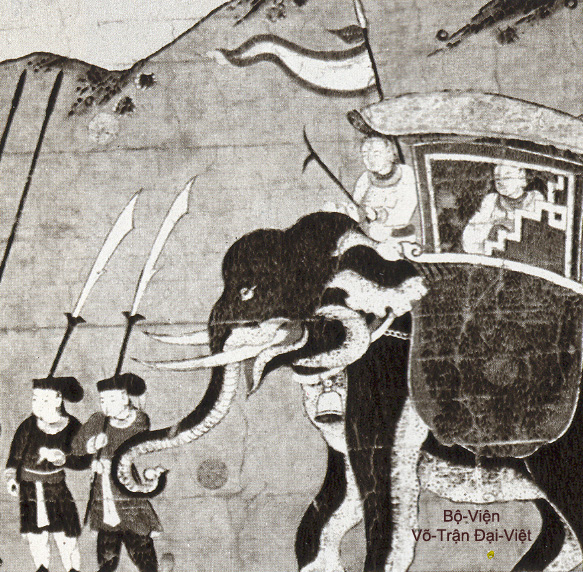
Đại-Việt's Elephant-Army using Polearm « Giáo-Đao »
holding an edged Hook.
LÊ Dynasty (1428-1527)
2 - When the Blade of Sabre is fixed to a handle of same lenght of the Blade for the use in cavalry, it's called « Long Sabre with Short Handle - Ðoản-Bính Trường-Ðao » (短 柄 長 刀) ; that's the « Category of Sabre with Large Blade » used more often as Two-Handed Sabre than One-Handed Sabre.
At the time of Minh Dynasty (1368 - 1644), it was named «Tiger Head Sabre - Hổ-Đầu Đao » (虎 頭 刀) or «Tiger-Fang Sabre - Hổ-Nha Đao » ( 虎 牙 刀 ).
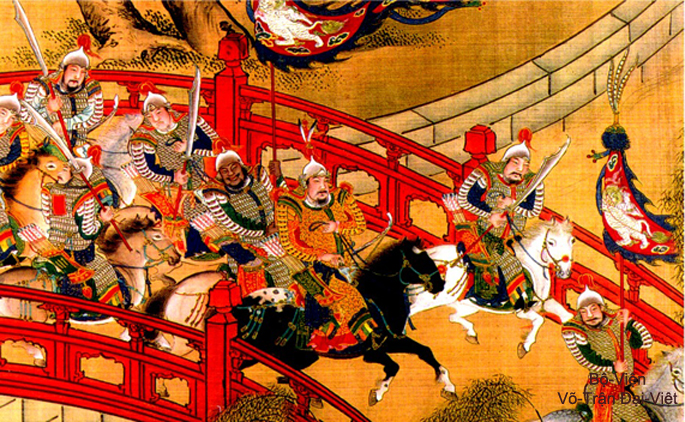
Cavalry using « Tiger-Head Sabre - Hổ-Đầu Đao » (虎 頭 刀)
still called « Tiger-Fang Sabre - Hổ-Nha Đao » (虎 牙刀).
MINH (MING - 1368 - 1644) Dynasty
(Photo Credit : Thomas CHEN )
3 - When the Blade of Sabre is fixed to a handle shortless than the Blade it's called « Long Sabre - Trường-Ðao » ( 長 刀). This Category of Sabre Long - Trường-Đao owns a Blade more narrow and includes Two kinds :
α) - The one of « Long Sabre with Narow Blade » from Combatants using the more often as One-Handed Sabre than as Two-Handed Sabre ; that's the Long Sabre used under the Posteriors-LÊ Dynasty Period (1427 - 1789) & Lords TRỊNH Dynasty Period (1545 - 1787) and still used under the NGUYỄN Dynasty Period (1802~1945). it was also used by Right Combatants of Warrior Chief Mai-Xuân-Thưởng from High Lands of Bình-Định and by Warriors-Women's battalions of Lady « Beo Gấm - Leopard of the South », spouse of General « Năm Lửa » during the period of armed conflict against french colonization.
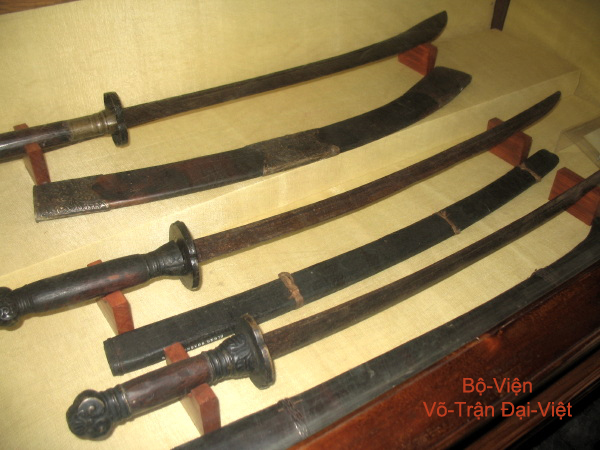
Đại-Việt « Long Sabre - Trường-Ðao » ( 長 刀)
LÊ- Posteriors Dynasty Period (1427 - 1789) & Lords TRỊNH Dynasty (1545 - 1787).
(Photo Credit : Nguyễn Ngọc Phương Đông)
β) - The one of « Long Sabre with Narow Blade » from Combatants using the more often as Two-Handed Sabre than as One-Handed Sabre ; that's the Long Sabre used under the Posteriors-LÊ Dynasty Period (1427 - 1789) & Lords TRỊNH Dynasty Period (1545 - 1787) and still used under the NGUYỄN Dynasty Period (1802~1945). it was also used by Right Combatants of Warrior Chief Mai-Xuân-Thưởng from High Lands of Bình-Định and by Warriors-Women's battalions of Lady « Beo Gấm - Leopard of the South », spouse of General « Năm Lửa » during the period of armed conflict against french colonization.
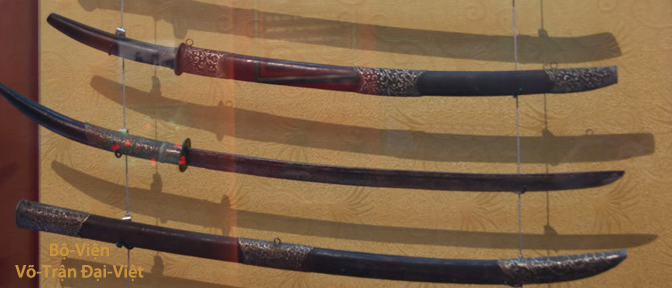
Đại-Việt « Two Handed Long Sabre - Song-Thủ Trường-Ðao » ( 長 刀)
- Period of LÊ Posterior Dynasty (1427~1789) & Lords TRỊNH (1545 - 1787) -
(Photo Credit : Nguyễn Ngọc Phương Đông)

Đại-Việt « Two Handed Long Sabre - Song-Thủ Trường-Ðao » ( 長 刀)
NGUYỄN Dynasty Period (1802 - 1945)
B) - The one of « Short Sabre - Ðoản-Ðao » (短 刀), is an edged weapon became celebrious in liberation armies from Tây-Sơn (1788-1802) through out victories wined over Mandchus.
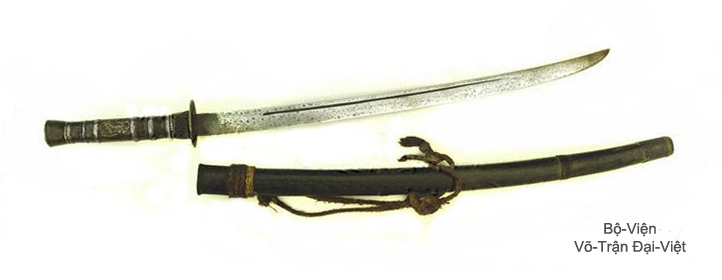
« Short Sabre - Đoản-Đao 腰 刀 » in Steel, holding Single Edge, from Đại-Việt.
(Circa 18th~19th centuries)
C) - The one of « Sabre Beared on one's Side - Yêu-Ðao » (腰 刀) belongs to sabres beared on one's hip, holding a narrow and curved Blade. The « Sabres » from Europe and Near East are also a kind of Yêu-Ðao (Sabres Beared on one's Side).
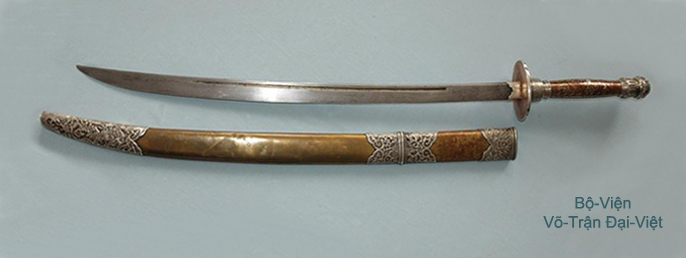
« Sabre Beared on one's Side - Yêu-Ðao » ( 腰 刀)
Đại-Việt - 18th~19th centuries.
(Photo Credit :Gavin Nugent, swordsantiqueweapons.com)
In nowadays, it still always exists many martial students who make the confusion between « Sabre Đao », « Great-Sabre Ðại-Ðao 大 刀 » and « Scimitar Mã-Tấu ».
- The « Sabre Đao » is a kind of single edge Sword with curved Blade, inherent in the category of « Sabre Beared on one's Side - Yêu-Ðao » (腰 刀) and it's wielded with One Hand.

« Sabre - Yêu-Đao 腰 刀 » in Steel, with Single Edge and with Ring Pommel.
( China - Re-Enactment for Training in Martial Arts Drill Halls)
( Photo Credit : Wing Lam Enterprises )
- When the « Sabre - Đao » owns a large Blade, it's called « Great-Sabre Ðại-Ðao » (大 刀), that means the Scimitar and it's wielded with Two Hands.
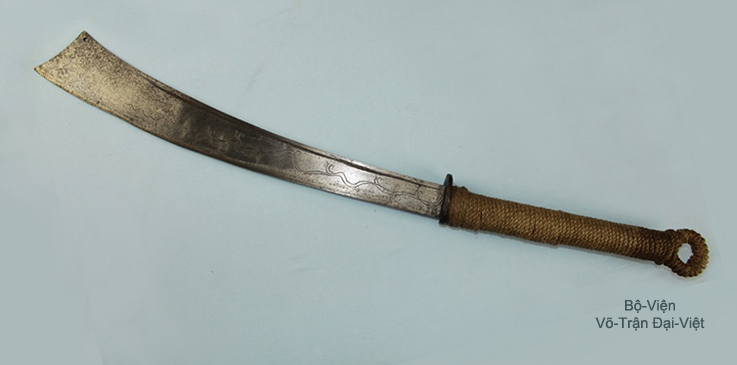
Long Sabre - Trường-Đao (長 刀) Two-Handed « Scimitar - Mã-Tấu »,
with specific décorations from Đại-Việt engraved on the blade.
(Photo Credit :Gavin Nugent, swordsantiqueweapons.com)
Currently, it still exist Vietnameses who make th error to call the « Cavalry Vouge Siêu-Ðao » (超 刀) by « Great-Sabre Ðại-Ðao » (大 刀) according to the way whom various chinese Martial Arts School have the habit to do it.
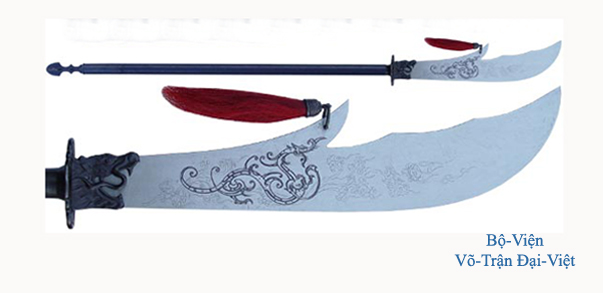
Vouge « Siêu-Đao combinated with Long-Đao » reconstructed
for the training in Martial Arts Drill Halls.
(Photo Credit : Wing Lam Enterprises)
- Mã-Tấu belongs to the category of « Long Sabre Trường-Đao » (長 刀), having a Larger Blade, a heavier weight than the « Sabre Đao », a handle about from 40 cm to 60 cm long. There is a king of weapon originate from « Tiger-Head Sabre Hổ-Đầu Đao » (虎 頭 刀).
The « Scimitar Mã-Tấu » is used with One Hand or with Two Hands, while the « Sabre Đao » is wielded only with One Hand.
In bygone days, Chineses warriors had been used this kind of Sabre Ðao with large Blade fot fighting on horseback, that's why this name « Horse Sabre Mã-Đao » (馬 刀), whom Vietnameses had pronounced « Mã-Tấu » by phonetic error. Later, this « Horse Sabre Mã-Tấu » had been employed for fighting on ground and called « Sabre for Cutting Horses Trảm-Mã Đao » (斬 馬 刀).
The « Sabre with Rings Hoàn-Đao » (環 刀), the « Sabre Beared on one's Back Bối-Ðao » (背 刀), all like the « Sabre with Ghost Head Quỷ-Ðầu-Ðao » (鬼 頭 刀), etc. from China, belong equally to this category of Edged Weapons called « Scimitar Mã-Tấu ».
Committee of TRỊNH Quang Thắng |
Copyright © 2004 - 2016 by ACFDV - All rights reserved.
